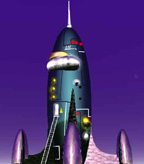 Geology Explorer
Geology ExplorerProject Details
Explorer
Project Details
WWWIC:
The World
Wide Web
Instructional
Committee
Other
WWWIC
Projects:
- Virtual Cell
- Visual
Computer
Science
-
Programming
Land
Museum
Go back to the
Geology
Explorer:
Planet Oit
Information
Page

|
The Geology Explorer
is implemented as a multi-user virtual environment and hosted on
the Internet. The players visit a simulated world, Planet Oit,
and compete for points by undertaking a goal directed
exploration where they perform simple experiments in order to
identify rocks and minerals.
|
|
| |
| Internet-based: the simulation is implemented using the client-server model. The server is our version of the LambdaMOO Object Oriented Database. The clients are implemented in Java. | Multi-user: because of the LambdaMOO/Java implementation, anyone with a network connection and a browser can visit the planet. |
| Low Bandwidth: the server is essentially text-based, and the communication protocol we have developed transmits control strings to manipulate downloaded graphics. | Two Versions: there is a low-bandwidth text-based version of the game, where scenes are described in English, as well as a graphical version. |
| Role-based: the immersive nature of the simulated environment is intended to engage players in processes that promote their acting like and thinking like a Geologist. | Learn-by-Doing: in order to succeed in the virtual environment players learn to perform the tasks of Geoscience; by operating as they need to succeed, they learn-by-doing Geology |
| Software Agents: the synthetic environment is populated by a diverse family of objects and agents; agents are of three types: atmosphere agents (who lend ambience to the game, eg. birds and other animals), infrastructure agents (who provide services in the simulation, eg. the equipment manager), and tutoring agents | Intelligent Tutoring: tutoring agents monitor player actions and unobtrusively intervene when errors are detected; these agents operate on deductive principles and are designed to remediate errors involved with navigation, equipment, and identification. See Intelligent Tutoring for more detail. |
| Principled Design: Planet Oit has been developed in order to simulate authentic Geosciences experiences; this "field trip" approach (also sometimes styled as the Virtual Laboratory to complement the Virtual Lecture) provides many opportunities for collaborative problem solving and virtual interaction; it also provides opportunities for experiences that would otherwise be impractical: due to danger, distance, expense, or physical impossibility. | Authentic Environment: Planet Oit has been designed as a coherent geophysical space where geological regions (desert, mountains, plains, etc.) contain plausible phenomenon (mesa, playa, cave, etc.) which are populated with plausible objects (outcrops, boulders, veins), of plausible types (limestone, fluorite, galena), which are situated with both local and global constraints on the design (i.e. a vein of anthracite in an upper elevation glaciated region entails deposits of anthracite at lower elevations); Planet Oit currently contains over 50 locations, nearly 100 rock and mineral types, 200 outcrops, veins, boulders and so forth, and over 40 instrument and tool types. |
Go back to the Geology Explorer: Planet Oit Information Page
For more information you can contact Brian Slator
Copyright © 1998-2002. World Wide Web Instructional Committee